
| Palaeos |  |
Glossary |
| Fungi | Glossary M |
| Page Back | Unit References |
Unit Dendrogram |
||
| Page Next |
The initial entries in this glossary were assembled in considerable haste. I tender my apologies to Jonathan Dixon, late of the University of Manchester, from whose glossary I borrowed liberally. Other gleanings are credited individually.
Mannose: see The Cell Wall.
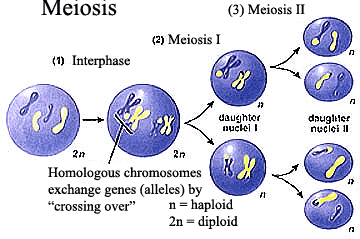 Meiosis:
A process common to almost sexual reproduction in eukaryotic cells. The
homologous chromosomes of a diploid nucleus first exchange homologous genes
(alleles) on a roughly random basis, so that the resulting chromosomes carry a
mixture of genes from each parent. The nucleus then divides normally (by
mitosis) to yield two diploid daughter nuclei. Finally, the nuclei divide
again, but now without DNA replication, to yield four haploid cells.
Meiosis:
A process common to almost sexual reproduction in eukaryotic cells. The
homologous chromosomes of a diploid nucleus first exchange homologous genes
(alleles) on a roughly random basis, so that the resulting chromosomes carry a
mixture of genes from each parent. The nucleus then divides normally (by
mitosis) to yield two diploid daughter nuclei. Finally, the nuclei divide
again, but now without DNA replication, to yield four haploid cells.
Meiospore: a spore formed after meiosis; a spore produced by sexual reproduction.
Meiosporangium: a sporangium in which meiosis occurs (reference to certain Chytrids).
Microtubule: Microtubules are protein structures found within cells. They are generally long and form a structural network (the cytoskeleton) within the cell's cytoplasm, but in addition to structural support microtubules are used in many other processes as well. They form a substrate on which other cellular chemicals can interact, they are used in intracellular transport, and are involved in cell motility. The assembly and disassembly of microtubules into their subcomponent tubulin is one way in which cells can change their shape. A notable structure involving microtubules is the mitotic spindle used by eukaryotic cells to segregate their chromosomes correctly during cell division. Microtubules are also responsible for the flagella of eukaryotic cells (prokaryote flagella are entirely different). From Microtubule - Wikipedia; see also, Structure and Function of Microtubules. Microtubules are straight, hollow cylinders have a diameter of about 25 nm are variable in length but can grow 1000 times as long as they are thick. Microtubules are built by the assembly of dimers of alpha tubulin and beta tubulin. Microtubules grow at each end by the polymerization of tubulin dimers (powered by the hydrolysis of GTP), and shrink at each end by the release of tubulin dimers (depolymerization). However, both processes always occur more rapidly at one end, called the plus end. The other, less active, end is the minus end. Microtubules participate in a wide variety of cell activities. Most involve motion. The motion is provided by protein "motors" that use the energy of ATP to move along the microtubule. From The Cytoskeleton.
Mitochondrion: an organelle responsible for most of the oxidative metabolism in the cell. There is far too much to cover in a glossary definition. See Mitochondrion - Wikipedia for a relatively brief introduction.
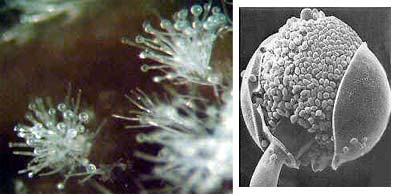 Mitosporangium:
a fungal organ which develops spores by mitosis, i.e. asexual spores. Image from Mycolog.com.
Mitosporangium:
a fungal organ which develops spores by mitosis, i.e. asexual spores. Image from Mycolog.com.
Monokaryon: a hypha having only a single, haploid nucleus.
Monophyletic: a group of organisms is said to be monophyletic if it consists of only an ancestral organism and all descendants of that organism. If the group does not contain the last common ancestor of its members, it is polyphyletic. If it contains the last common ancestor of all members, but not all of the descendants, it is termed paraphyletic. A monophyletic group is called a clade. The significance of all this is explained at Dendrograms.
mtDNA: each mitochondrion has its own small DNA genome which does not undergo recombination. In higher plants and in animals, both of which have well-differentiated microgametes (sperm) and macrogametes (eggs), the mitochondria of offspring are all decended from the mitochondria in the macrogamete. It is not obvious that this should be the case in Fungi, given their more egalitarian mating practices; and we are unsure if the same rule applies.
Mushroom: fleshy, sometimes tough, umbrella like basidiocarp of certain Basidiomycota.
Mycelium: a network of numerous hyphae which develop within or along the substrate. "The spore and initial hyphae are haploid; that is, they contain only one copy of each chromosome. When a haploid mycelium meets another haploid mycelium of the same species, and they are sexually compatible, the two mycelia join together and each cell receives a nucleus from the other mycelium. This process is called diploidization. Some authors seem to want to reserve the term mycelium for hyphae that have undergone diploidization (the earlier, haploid stuff is just hyphae), but most people seem to use it for both phases." hypha.
Mycorrhizal association: a symbiotic relationship between fungus and plant in which the fungus interpenetrates the roots, mobilizing soil nutrients for the plant and absorbing complex organics produced by the plant.
Necrotrophic: growing by first killing the host organism or mycelium.
Oidium: a small, specialized haploid mating spore which fuses with a haploid hypha to produce a dikaryon.
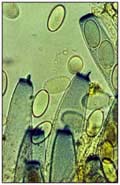 Operculum:
a lid. Thus, for example, the asci of
some pezizomycotines
have a sort of lid at the distal end which opens and releases the spores at
maturity. In the image, the opercula are stained blue. Image from North
Carolina State Univ., College of Agriculture & Life Sciences.
Operculum:
a lid. Thus, for example, the asci of
some pezizomycotines
have a sort of lid at the distal end which opens and releases the spores at
maturity. In the image, the opercula are stained blue. Image from North
Carolina State Univ., College of Agriculture & Life Sciences.
Osmotic pressure: Most biological membranes are impermeable to many of the solutes found in the cell. If this were not so, all of the valuable biomolecules in the cell would simply diffuse out and be lost. However, the same membranes are often more or less permeable to water. Since there are many solutes trapped in the cell, the "concentration" of water is lower in the cell than outside, i.e., there are more water molecules per unit volume outside the cell than inside. Diffusion of water through the membrane works both ways and is completely random. However, water "concentration" is higher outside the cell. That is, there are more water molecules in contact with the membrane on the outside than on the inside. So, there will be a net flux of water into the cytoplasm until the concentrations equalize. The osmotic potential is the measure of the net tendency of water to enter the cell. Real cells can't usually behave in this fashion, since the cell will expand and ultimately burst. The problem is handled in numerous different ways, depending on the cell type. In fungal cells (and various others), the cell membrane is confined within a semi-rigid cell wall. Water enters the cell only until the elastic reaction force of the cell wall equals the outward force caused by water molecules crowding into the cell. At steady state, the cell then maintains a rather high internal pressure, referred to as turgor pressure. Turgor pressure serves as a sort of internal hydrostatic skeleton which helps to support -- and even move -- fungal structures.
Ostiole: a pore or hole in an enclosing ascocarp for the release of spores.
 Oxidation:
in the sense used by chemists, this means the removal of electrons from an outer
electron shell. Oxidation often involves the use of oxygen, but oxygen is
not necessarily required. As a practical matter, the removed electrons
have to go somewhere, so biological oxidation is a matter of coupling the
oxidation of one chemical with the reduction of another. So, what does
this accomplish? The trick here is that the resulting product(s) may have
lower energy than the starting products. The energy released by the
reaction is used by the organism for its own nefarious purposes.
Typically, in biological systems, oxidation of chemicals from a food item is
coupled with reduction of a special-purpose carrier molecule. That carrier
can then dock with any number of enzymes, proteins that perform all the chemical
chores needed by a living cell. The enzymes then use the energy stored in
the carrier by coupling oxidation of the carrier with a reduction reaction which
performs the job the enzyme was evolved to accomplish. Examples from real life
tend to be complex, so we'll use a simplified and somewhat unrealistic example
involving the carrier nicotinamide- adenine dinucleotide (NAD), a common carrier
in the metabolic reactions handled by enzymes in mitochondria. In this
example, the energy released by oxidation is stored in three different ways, all
of which are important to biological systems. (1) the energy is first
stored in the form of an excited intermediate state of an enzyme. This
typically involves a slight change in the shape of the protein. As the
protein drops back to its normal state, the change in shape drives the next
reaction. (2) The energy is stored by reducing a carrier molecule, here
the coenzyme NAD+, as discussed above. (3) The reaction
produces an ion, here H+. Over many such reactions inside a
membrane system (from an entire cell to a single mitochondrial
crista), a
gradient develops across the membrane. This can be used to drive other
types of reactions as discussed elsewhere.
Oxidation:
in the sense used by chemists, this means the removal of electrons from an outer
electron shell. Oxidation often involves the use of oxygen, but oxygen is
not necessarily required. As a practical matter, the removed electrons
have to go somewhere, so biological oxidation is a matter of coupling the
oxidation of one chemical with the reduction of another. So, what does
this accomplish? The trick here is that the resulting product(s) may have
lower energy than the starting products. The energy released by the
reaction is used by the organism for its own nefarious purposes.
Typically, in biological systems, oxidation of chemicals from a food item is
coupled with reduction of a special-purpose carrier molecule. That carrier
can then dock with any number of enzymes, proteins that perform all the chemical
chores needed by a living cell. The enzymes then use the energy stored in
the carrier by coupling oxidation of the carrier with a reduction reaction which
performs the job the enzyme was evolved to accomplish. Examples from real life
tend to be complex, so we'll use a simplified and somewhat unrealistic example
involving the carrier nicotinamide- adenine dinucleotide (NAD), a common carrier
in the metabolic reactions handled by enzymes in mitochondria. In this
example, the energy released by oxidation is stored in three different ways, all
of which are important to biological systems. (1) the energy is first
stored in the form of an excited intermediate state of an enzyme. This
typically involves a slight change in the shape of the protein. As the
protein drops back to its normal state, the change in shape drives the next
reaction. (2) The energy is stored by reducing a carrier molecule, here
the coenzyme NAD+, as discussed above. (3) The reaction
produces an ion, here H+. Over many such reactions inside a
membrane system (from an entire cell to a single mitochondrial
crista), a
gradient develops across the membrane. This can be used to drive other
types of reactions as discussed elsewhere.
Palisade: series of parallel hyphae having the appearance of a wall or fence -- or even a palisade.
Paraphysis: (pl. paraphyses) a poorly-constrained term which seems to include every sort of generally elongate cell in a perithecium (or similar structure) which is not actually an ascus.
Perfect state: sexual state of a fungus, also known as the teleomorph in a life cycle.
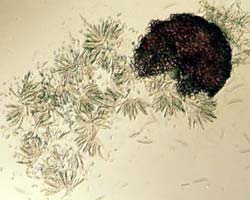 Peridium: the outer membrane of a
mitospore. See image at mitosporangium. In
that image, the
peridia are the two structures which look a bit like compound eyes in the
electron micrograph. A more familiar example of a peridium may be the
outer sac visible on fungal puffballs. The term is not restricted to
strictly cleistothecial (completely enclosed) ascocarps (spore organs).
Any outer membrane which encloses spores, even if not completely, is a
peridium. The image here shows a peridium in the process of dehiscence.
I have lost the source of this image.
Peridium: the outer membrane of a
mitospore. See image at mitosporangium. In
that image, the
peridia are the two structures which look a bit like compound eyes in the
electron micrograph. A more familiar example of a peridium may be the
outer sac visible on fungal puffballs. The term is not restricted to
strictly cleistothecial (completely enclosed) ascocarps (spore organs).
Any outer membrane which encloses spores, even if not completely, is a
peridium. The image here shows a peridium in the process of dehiscence.
I have lost the source of this image.
Periphysis: a paraphysis (elongate sterile cell) which grows into the neck of a perithecium. See image at perithecium.
Perithecial: relating to a perithecium.
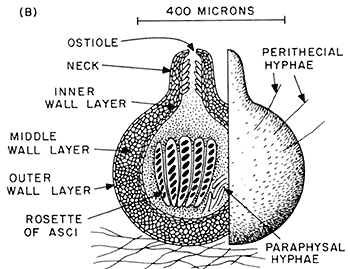 Perithecium:
A form of ascocarp in which the peridium (outer
membrane) is almost closed but for an ostiole (pore) at
the distal end. Image from Johnson
(1978).
Perithecium:
A form of ascocarp in which the peridium (outer
membrane) is almost closed but for an ostiole (pore) at
the distal end. Image from Johnson
(1978).
Phylogenetic: relating to the evolution of a taxon or, more specifically, the particular evolutionary context of a taxon. Thus, a phylogenetic definition is one which defines a taxon by its evolutionary path, e.g., Archosauria = crocs + rocs. This is shorthand for "Archosauria is defined as the last common ancestor of crocodiles and birds and all descendants of that ancestor." This is discussed in connection with the Fungi on the opening page.
Phylospace: a portmanteau word used to describe the placement of organisms in space, time and phylogeny. It is an evolving concept, so to speak.
Plasmodium: a naked, multinucleate mass of protoplasm that moves and feeds in a amoeboid fashion.
Plasmogamy: fusion of two cell cytoplasms.
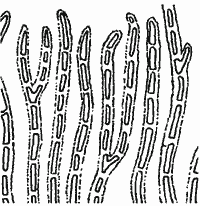 Plectenchymatous:
having strongly parallel oriented hyphae (a palisade) which rarely branch or
overlap one another, as in the image.
Plectenchymatous:
having strongly parallel oriented hyphae (a palisade) which rarely branch or
overlap one another, as in the image.
Polysaccharide: see The Cell Wall.
 Prototunicate:
"Some asci have no active spore-shooting
mechanism. These asci are usually more or less spherical, and are found in cleistothecial
(occasionally perithecial), and hypogeous ascomata. Sometimes the wall of this
kind of ascus dissolves at maturity and releases the ascospores, which can then
ooze, rather than be shot, out of the ascoma; or they may wait inside until it
decays or is ruptured. These asci are often called prototunicate. ... [T]hey are
found in several otherwise rather different orders, [and] it seems likely that
they represent a secondary condition, [which has] evolved several times from
unitunicate asci." Ascomycetes and anamorphs.
The term may be used simply to mean spores withoutany mechanism for ballistospory.
Such spores typically have a fragile membrane which disintegrates spontaneously
at maturity or breaks open with very slight mechanical stress. Image from Mycolog.com.
Prototunicate:
"Some asci have no active spore-shooting
mechanism. These asci are usually more or less spherical, and are found in cleistothecial
(occasionally perithecial), and hypogeous ascomata. Sometimes the wall of this
kind of ascus dissolves at maturity and releases the ascospores, which can then
ooze, rather than be shot, out of the ascoma; or they may wait inside until it
decays or is ruptured. These asci are often called prototunicate. ... [T]hey are
found in several otherwise rather different orders, [and] it seems likely that
they represent a secondary condition, [which has] evolved several times from
unitunicate asci." Ascomycetes and anamorphs.
The term may be used simply to mean spores withoutany mechanism for ballistospory.
Such spores typically have a fragile membrane which disintegrates spontaneously
at maturity or breaks open with very slight mechanical stress. Image from Mycolog.com.
Pseudoparaphysis: pseudoparaphyses are long, hair-like cells which grow down from the roof of the locule and often attach to its base. See image at pseudothecium.
Pseudoparenchyma: thin-walled, usually angular, randomly-arranged cells in fungi, which are tightly packed. Often used to form walls in specialized structures such as ascocarps. They are similar in appearance to the parenchyma cells of plants and have some of the same functions, i.e. as a population of undifferentiated cells competent to form various different types of specialized tissues.
 Pseudothecium:
perithecium-like fruiting body containing asci and ascospores dispersed rather
than in an organized hymenium; an ascostroma with a locule or cavity and
containing bitunicate asci.
Pseudothecium:
perithecium-like fruiting body containing asci and ascospores dispersed rather
than in an organized hymenium; an ascostroma with a locule or cavity and
containing bitunicate asci.
Pyranose: see The Cell Wall.
rDNA: the DNA which codes for ribosomal RNA. If that term isn't familiar, see the Cell Biology summary at Eubacteria. However, there are some significant differences. In contrast to prokaryotes, the four RNAs contained in eukaryotic ribosomes are coded by two types of genetic units which are generally not linked. Each type occurs in its own randomly repeated clusters. The larger unit, the rDNA, is transcribed by RNA polymerase I as a single precursor containing the small subunit (18S) rRNA, 5.8S rRNA and the large subunit (28S) rRNA, each bracketed with spacer sequences. The second type of unit codes for 5S rRNA and is transcribed by RNA polymerase III. Peyretaillade et al. (1998).
Reverse transcriptase: an enzyme so called because it operates in a manner which reverses normal transcription. That is, a reverse transcriptase uses RNA as a template to create a complementary single-stranded DNA molecule.
Rhizoid: a short, thin branch of thallus, superficially resembling a root.
Ribozyme: an RNA molecule with catalytic properties, typically in association with a cofactor such as a neucleotide or metal ion.
Rust fungus: fungus belonging to the Uredinales.
Saprobe: same as saprophyte
Saprophyte: an organism which feeds on dead organic matter.
Septal pore: a possible synapomorphy of the Ascomycota. The hyphae of ascomycetes are partitioned off into compartments by septal walls. The septae are bridged by pores which provide controlled cytoplasmic continuity throughout the hypha. See Woronin body for image and additional information.
Septate: with more or less regularly occurring cross-walls.
Septum: a cross-wall in a hypha that develops centripetally.
Slime mould: common term for members of Dictyosteliomycota, Acrasiomycota, Plasmodiophoromycota and Myxomycota.
Smut fungi: fungus belonging to the Ustilaginomycetes.
Spliceosome: a nuclear ribonucleoprotein complex which (usually along with other functions) removes intron transcripts from newly synthesized RNA.
Sporangiophore: sporangia borne on stalks, or the specialized hyphae which bear sporangia.
Sporangiospore: a spore with a nucleus formed by mitosis, an asexual spore. There seem to be an unreasonable number of names for this concept.
Sporangium: a structure in which spores are created and released into the environment.
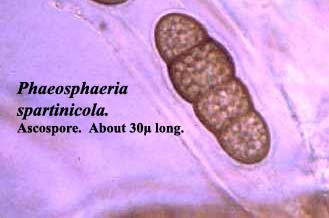 Spore:
"Biologically speaking, a fungal spore is a microscopic reproductive unit
one or multicelled, used by fungi and other organisms on dispersal of new
individuals. Spores contains some food reserve, usually oil or glycogen, they
can be produced by meiosis or not. Even if spores are mostly dispersive units,
some act as resting structures over unfavorable conditions as intense cold or prorogated [sic]
drought. The great majority of spores posses firm cell walls. The
most recognizable characteristics used to identify spores are color, size,
shape, septation and surface characteristics (e.g. ornamentation). However all
of them should be very variable even for a genus alone." MycoSpora - generalities.
"By wet weight spores generally contain 25% protein and 20% fat, and they
have a low water content relative to vegetative mycelium. Cell walls of spores
are generally not fibrillar, but they are multi-layered and often contain
melanin and have ornamentations. Spores contain all normal mycelial organelles.
Respiratory reserves include lipids, glycogen, phospholipids and polysaccharides
that can include sugar alcohols like Trehalose). Respiration rates in spores are
only 1-4% those of vegetative mycelium, but obviously the more reserves a spore
has, the longer it will survive." Reproduction in the fungi (former
site).
Image from Steve Newell, Univ.
Georgia.
Spore:
"Biologically speaking, a fungal spore is a microscopic reproductive unit
one or multicelled, used by fungi and other organisms on dispersal of new
individuals. Spores contains some food reserve, usually oil or glycogen, they
can be produced by meiosis or not. Even if spores are mostly dispersive units,
some act as resting structures over unfavorable conditions as intense cold or prorogated [sic]
drought. The great majority of spores posses firm cell walls. The
most recognizable characteristics used to identify spores are color, size,
shape, septation and surface characteristics (e.g. ornamentation). However all
of them should be very variable even for a genus alone." MycoSpora - generalities.
"By wet weight spores generally contain 25% protein and 20% fat, and they
have a low water content relative to vegetative mycelium. Cell walls of spores
are generally not fibrillar, but they are multi-layered and often contain
melanin and have ornamentations. Spores contain all normal mycelial organelles.
Respiratory reserves include lipids, glycogen, phospholipids and polysaccharides
that can include sugar alcohols like Trehalose). Respiration rates in spores are
only 1-4% those of vegetative mycelium, but obviously the more reserves a spore
has, the longer it will survive." Reproduction in the fungi (former
site).
Image from Steve Newell, Univ.
Georgia.
Stereochemistry: see The Cell Wall.
Stroma: (pl. stromata) fungal tissue mass of pseudoparenchyma in or on which the reproductive structures (perithecia) are formed in some sac fungi. More generally, a mass or matrix of vegetative hyphae, with or without tissue of the host or substrate, in or on which spores are produced.
Suspensor: in Zygomycota, the remains of the gametangia that project from the sides of the zygosporangium which has developed between them. See the image at gametangium.
Synapomorphy: a character which is shared by all basal members of a clade and is derived from their common ancestor. A synapomorphy may be secondarily lost in later descendants. Only a synapomorphy may be used to infer phylogeny.
Teleomorph: the sexual form of a fungus; unknown in many taxa (see also anamorph).
Thallus: Fungi have a vegetative body normally located above the substrate called a thallus or soma, composed of hyphae. In botany, a thallus is a relatively simple plant body devoid of stems, leaves and roots. In fungi, it is the somatic phase.
Toadstool: a member of the "Agaricales" or "Boletales" (both probably polyphyletic) with an inedible fruiting body.
Transcript: one nucleic acid is the transcript of another if it was synthesized using the original nucleic acid as a template, so that the base sequence of the transcrip is comlementary to the base sequence of the template. By far the most common transcription is the synthesis of RNA in the nucleus by an RNA polymerase, using the organism's DNA as a template. Thus the DNA sequence AAAGGTTCAGT is transcribed as an RNA with sequence UUUCCAAGUCA (RNA contains Uracil bases where DNA has Thymidine). In cell biology and biochemistry, transcription is contrasted with translation, the process in which the base sequence of messenger RNA (mRNA) is used as a template to create proteins.
Turgor pressure: see osmotic pressure.
Type: in systematics, a group defined by a set of physical characteristics, rather than by phylogeny. Compare clade.
Unitunicate: an ascus without differentiated inner and outer walls is said to be unitunicate. "The unitunicate ascus sometimes has an operculum (a small lid), which opens to liberate the ascospores when the ascus is mature. These asci are called unitunicate-operculate. ... Other asci have no operculum but have an apical pore and/or a ring-like structure at the tip, acting as a valve, or sphincter, through which the ascospores are violently discharged and are dispersed by the air. Such asci are called unitunicate-inoperculate ... There are still other perithecial fungi with unitunicate asci which have no obvious mechanism for ascospore release. In this case, the ascospores are released into the cavity of the ascomata, when the ascus wall disintegrates." Guarro et al. (1999: 467).
Uredospore: dikaryotic spore of rust fungi produced in the second host and capable of reinfecting it.
Vegetative: assimilative phase in fungi, structure or function as distinguished from the reproductive.
White rot: fungal decay of wood in which both cellulose and lignin are broken down.
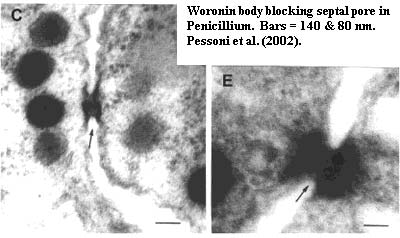 Woronin body: Woronin bodies are highly
refractive, electron dense, membrane bound particles found on either side of
septae that divide hyphal compartments in filamentous fungi. One current
theory is that Woronin bodies are peroxisomes that function to maintain cellular
integrity. The septae separate hyphal compartments are pierced by pores
which allow most cytoplasmic constituents (but not nuclei) to travel freely
between hyphae. However, if an adjoining hypha is ruptured, the Woronin
bodies block the pore to prevent loss of cytoplasm into the ruptured
compartment. Image: Pessoni
et al. (2002).
Woronin body: Woronin bodies are highly
refractive, electron dense, membrane bound particles found on either side of
septae that divide hyphal compartments in filamentous fungi. One current
theory is that Woronin bodies are peroxisomes that function to maintain cellular
integrity. The septae separate hyphal compartments are pierced by pores
which allow most cytoplasmic constituents (but not nuclei) to travel freely
between hyphae. However, if an adjoining hypha is ruptured, the Woronin
bodies block the pore to prevent loss of cytoplasm into the ruptured
compartment. Image: Pessoni
et al. (2002).
Yeast: single-celled ascomycete fungus that reproduces by budding or fission. The "true yeasts" are the Saccharomycotina.
Zoospores: a motile, asexually produced spore.
 Zygosporangium: the
teleomorph of the Zygomycetes; a usually thick-walled, often ornamented,
multinucleate resting sporangium formed following anastomosis of gametangia
arising from compatible mycelia (in heterothallic
species) or from the same mycelium (in homothallic species).
Zygosporangium: the
teleomorph of the Zygomycetes; a usually thick-walled, often ornamented,
multinucleate resting sporangium formed following anastomosis of gametangia
arising from compatible mycelia (in heterothallic
species) or from the same mycelium (in homothallic species).
Zygote: a diploid cell resulting from the union of two haploid cells.
checked ATW050809